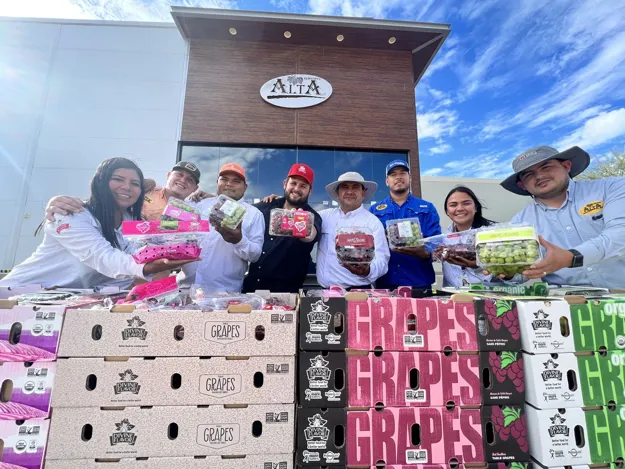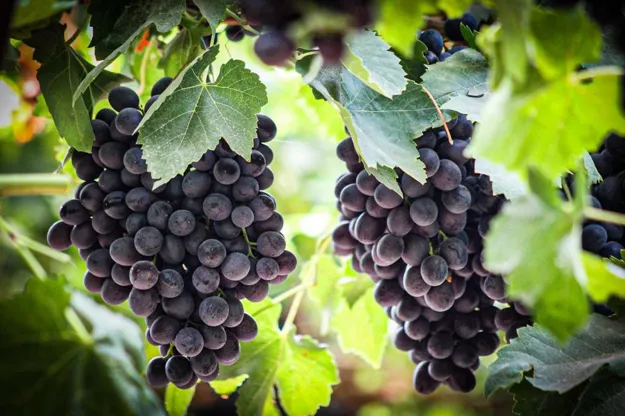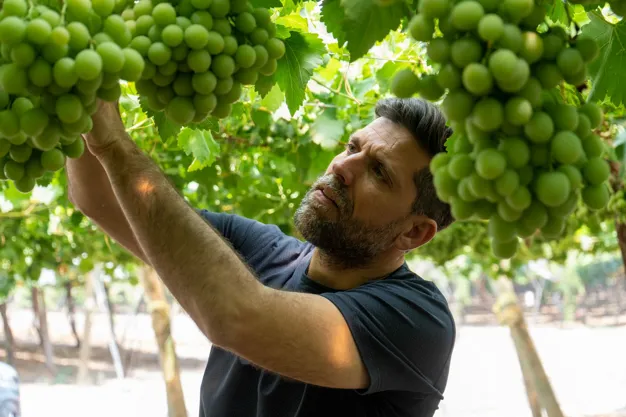The Mexican grape season kept getting pushed back due to a May month that was unusually cool. Although the weather helped with the coloring of the grapes, it slowed down the maturity. “The grape season has been late before, but this was probably the latest it has ever been,” says Carlos Bon with Divine Flavor. “In the past, the early districts of Sonora such as Guaymas and Pesqueira used to start harvest the last days of April. It seems those days are well behind us now and as of late, the new norm has been for early varieties to start around May 10th or 12th.”
This year, it was a lot later than that. Even harvest in the latest district Caborca was delayed and the region is still harvesting right now while normally it has wrapped up around this time. “We are just halfway done with our Cotton Candy and still have 50 percent of the crop left.”
 Team Grupo Alta, grower of Divine Flavor's table grapes.
Team Grupo Alta, grower of Divine Flavor's table grapes.
Mediocre quality on green grapes
The grape season started with an empty pipeline and then went to an ‘okay’ pipeline within ten days. “By mid-June the market on green grapes collapsed. This wasn’t necessarily caused by the number of grapes available, but I think it was more related to grapes competing with a lot of other items at that time,” Bon said. California and Washington were bunched up together with very big cherry volumes at aggressive prices, which significantly cannibalized grape sales on both colors. In addition, he believes the collapse was driven by disappointment about quality.
“Mexican grapes coming in around late May were mediocre at best, including some of our own product. We always hold ourselves to a high standard, but I think the end of May was the least ideal quality we’ve shipped all year. There was a lot of pressure to get volume out there, but it wasn’t a piece of fruit we felt proud about.” As a result, sales on green grapes were lost.
Low Brix on red grapes
“On red grapes, the situation was even crazier,” admitted Bon. Sizes were smaller than usual and sugar levels were lower. “Usually, in the Sonora growing region, sugar on red grapes comes in faster than the color and typically, we need to wait on color. However, with May being so cool, fruit colored up better than ever. We had full, bright colorful Flames that would barely get 16.5 Brix, where in a normal year, Sonora is producing the variety at above 19 Brix.” On cooler years like this, the acidity of the grape lingers longer, and the heat is needed for the acidity to dissipate. All in all, Brix levels on red grapes were lower and acidity was higher. “This situation in combination with grapes being expensive at a time when a lot of stone fruit and cherries came online, resulted in the overall consumption of grapes dying.”
“However, once we got into our later varieties as well as the later Flames and Sugraones, quality drastically improved. It’s our best stuff that is often the cheapest because by the time we get to our sweet varieties (Sweet Celebration, Sweet Globe, Timpson, and Jack Salute), the market is priced a lot more reasonably,” commented Bon. It was a banner year for Sweet Globe, as well as a great year for Sweet Celebration. “For black grapes, it was probably the best Sable Seedless we’ve ever had.”
 Sable Seedless grapes.
Sable Seedless grapes.
Price drop
Pricing on Mexican grapes usually starts off high and then comes down. Because of an empty pipeline, pricing started off higher than usual this year and dropped to the usual low. “However, coming from a much higher level, it was definitely a bigger drop. This season we set a Guinness world record market drop,” said Bon. “One Saturday, boxes were selling in the high $40s FOB and next, pricing was in the high $10s. In just one week, the market dropped by 50 percent. “Flames usually start off around $26/box and then drop into the mid-teens. This year, those same Flames started off at $50 and dropped back to the $10 range.”
The Mexican grape harvest has pretty much wrapped up now and is expected to come in at 24.5 million boxes at most. “As of right now, we are the last grower standing with a very late vineyard in Caborca. We have implemented innovative techniques and technology to get into this late window. With our late-season only varieties, our strategy is to provide proprietary varietals to our customers until the California season kicks off. Our last harvest is expected to take place Tuesday, July 25.”
 Carlos Bon.
Carlos Bon.
Great quality fruit sells
Summarizing, it’s hard to describe how challenging the Mexican grape season was. Perhaps the color of Bon’s beard shows. “By the time the season started, my beard was only half grey and it’s now 100 percent grey,” he said. “What stands out the most about this season is the importance of growing good grapes. When we were in the middle of our early Jalisco deal, there were no grapes in the market while we had the best Autumn Crisp® I’ve ever seen in my life. They were priced at $3.99 retail or $50 FOB, but people couldn’t get enough. We were surprised to see how repeat purchases were at an all-time high. The bottom line is if you can grow a fantastic piece of fruit, people are always going to come back for more. That’s something I’ve always known, something I’ve always said. If there’s something we learned from the Mexican grape season, and what Jalisco showed us is that great quality fruit sells.”
 For more information:
For more information:
Michael DuPuis
Divine Flavor
Tel: +1 (520) 281-8328
mdupuis@divineflavor.com
www.divineflavor.com
